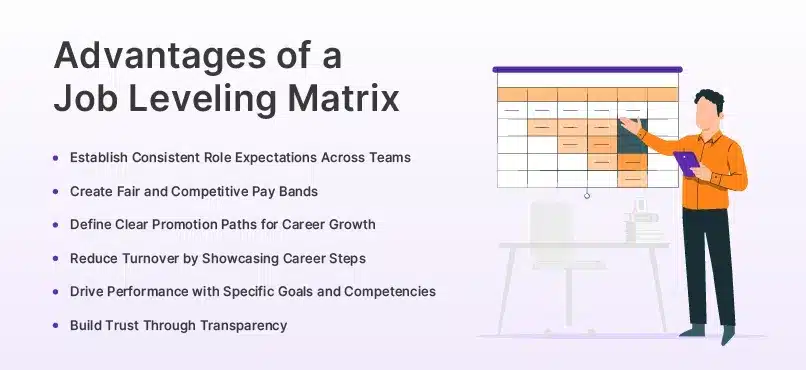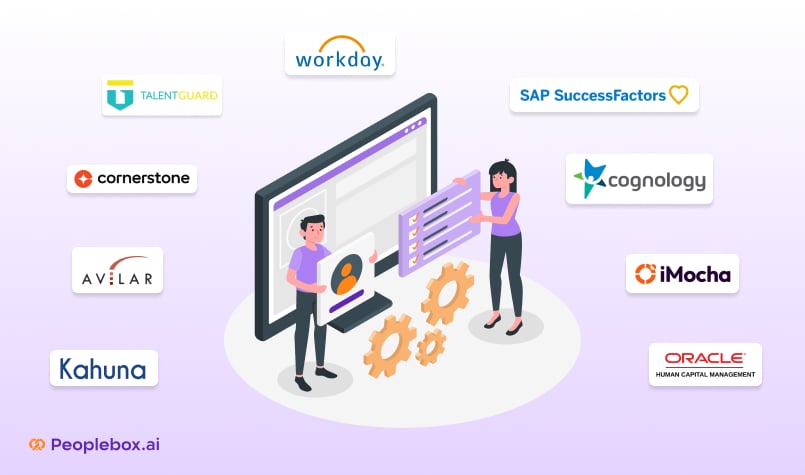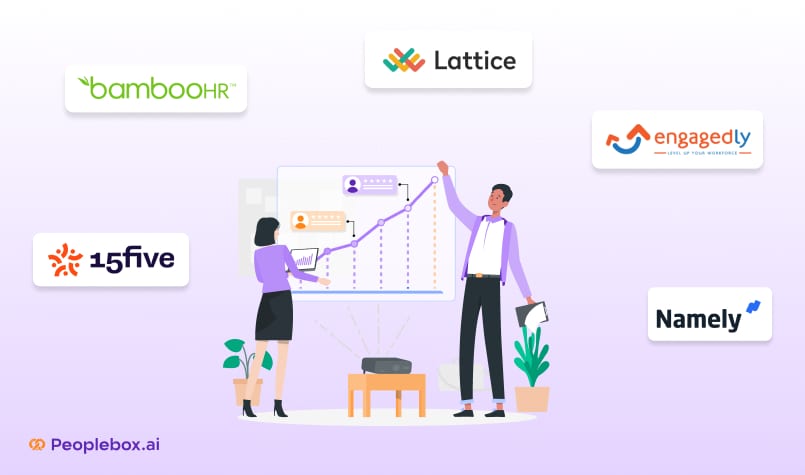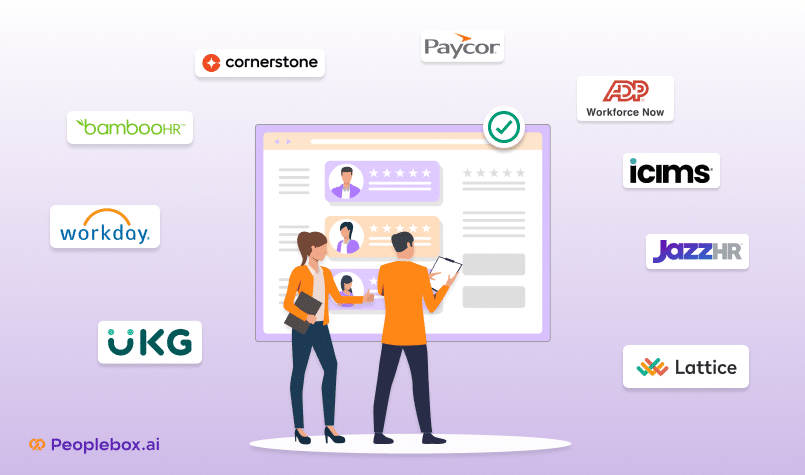A job leveling matrix can transform your organization, yet its absence leads to:
😡 Engineers questioning their Level 2 status while watching colleagues get promoted.
🤯 Managers struggling to explain career paths to their teams.
😢 HR grappling with compensation bands that don’t quite make sense.
Does this sound familiar?
Even the most organized companies stumble when it comes to structuring teams and creating clear growth paths. Without a proper system in place, it’s like trying to build a house without a blueprint—messy, frustrating, and bound to cause problems.
Enter the job leveling matrix: Your organization’s career GPS. It’s a powerful tool that clearly defines roles, growth opportunities, and expectations, helping employees understand where they stand and where they can go next.
This guide will explain everything you need to know about job-leveling matrices and show you how to implement one that actually works. Plus, you’ll get access to a free, customizable template to start implementing it right away!
What is a Job Leveling Matrix? A Must-Know for HR Professionals
A job leveling matrix is a visual tool that you can use to define and categorize job roles based on criteria like skills or competencies, responsibilities, level of experience, or impact of the role on the organization.
It’s also a framework that helps align talent management with your overall business strategy for improved talent outcomes. By clearly defining the expectations and impact for each role, a job leveling matrix helps cultivate and retain a motivated workforce with minimal effort.
Furthermore, a well-structured job leveling matrix will help managers make unbiased decisions on compensation and succession planning. The clarity offered by a job leveling matrix also enables companies to respond swiftly to market demands by quickly identifying skill gaps and areas for upskilling.
A Practical Example of Job Leveling Matrix: From HR Coordinator to Senior HR Director
In order to understand the job leveling matrix better, let us go through an example. The below matrix demonstrates how an HR position can be categorized across four levels in an organization. Each level has clearly defined skills, competencies, responsibilities, and expectations that increase progressively with levels.
| Level | Job Title | Skills & Competencies | Responsibilities | Performance Expectations |
| Level 1 | HR Coordinator | – Basic knowledge of HR policies – Strong communication – Administrative skills | – Assists with onboarding – Maintains employee records- Supports recruitment processes | – Meets administrative deadlines- Handles basic employee inquiries- Ensures data accuracy |
| Level 2 | HR Specialist | – Intermediate HR knowledge – Strong experience in recruiting – Familiarity with HRIS software | – Conducts interviews- Manages employee relations- Provides HR support to departments | – Handles issues with minimal supervision- Resolves employee concerns effectively- Improves candidate experience |
| Level 3 | HR Manager | – Advanced HR expertise – Leadership skills – Strategic thinking- Compliance knowledge | – Develops HR strategies- Oversees HR team- Manages policy implementation- Ensures legal compliance | – Successfully drives HR initiatives- Improves employee engagement – Maintains regulatory compliance |
| Level 4 | Senior HR Director | – Expert-level HR knowledge- Strategic planning- Change management- Stakeholder engagement | – Leads organizational development- Shapes HR policies- Partners with leadership to align HR with organization’s goals | – Improves retention, – Enhances HR program effectiveness- Drives cultural alignment with company vision |
As you can see, the above matrix charts out the potential career pathways for employees at each level, providing them and the management with a clear understanding of how it aligns with the company’s growth.
By customizing similar matrices for different roles, you can build a pool of skilled and motivated workforce who know their responsibilities.
💰 What is the ROI of Implementing a Job Leveling Matrix?
Despite the simplicity, a job leveling matrix is a strategic investment for any organization looking to improve transparency, productivity, job satisfaction, and retention. Here are the key advantages offered by a job leveling matrix:

01 Crystal Clear Role Expectations That Align Team Performance
As we have seen in the example, a job leveling matrix establishes uniform expectations for a role. By mapping specific competencies to each level, you ensure that employees at similar levels contribute and fulfill their responsibilities with aligned expertise.
This also improves cross-functional teamwork and reduces role ambiguities.
02 Competitive and Fair Compensation Strategies That Attract Top Talent
A job leveling matrix helps you create pay bands that are fair and competitive. This is one of the drivers of attracting and retaining talent. By setting salaries aligned with each role’s skills and responsibilities, you ensure market competitiveness and internal equity.
Fair pay bands based on role levels also reduce compensation-related grievances.
03 Transparent Career Progression Roadmaps for Employee Growth
Ask someone looking for new job opportunities why they are leaving the organization; a sizable number will cite ‘unclear career progression’ as one of the reasons. A job leveling matrix eliminates this situation by outlining specific skills and achievements needed to advance.
This makes promotion pathways and career development opportunities transparent, which motivates employees to upskill.
04 Retention Strategies That Keep Your Best Talent Engaged
When employees can see clear, structured career paths within the organization, they are more likely to stay committed to your organization. The job leveling matrix provides employees with visibility into their next steps, which encourages them to build skills and stay with the company longer.
Lower employee turnover or higher employee retention translates into cost savings on hiring, onboarding, and training.
05 Performance Management That Drives Meaningful Results
A job leveling matrix allows managers to set meaningful and level-specific performance goals. This can motivate employees to perform at their best. Each level includes distinct competencies, so employees know exactly what they need to achieve to excel.
This clear alignment between roles and goals drives better performance and improves the workforce’s productivity.
06 Building Organizational Trust Through Total Transparency
Transparency in job aspects such as salary range and advancement criteria creates trust between employees and management. A well-defined job leveling matrix outlines the criteria for both salary ranges and promotions.
It reassures employees that their contributions will be recognized and valued and that they will be adequately compensated for them. These actions demonstrate the organization’s commitment to transparency.
Now that we’ve covered the basics, let’s examine the 8 easy steps to creating a job-leveing matrix.
How to Create a Job Leveling Matrix in 8 Simple Steps?
Here are the different steps you need to follow meticulously to create a usable job leveling matrix:

Step 1: Set Measurable Goals
Begin by defining clear, measurable goals that align with your organization’s objectives. For example, aim to reduce employee turnover by 10%. Establish a realistic timeline for the project to keep it on track, allowing time for data collection, design, rollout, and training.
Additionally, allocate a budget to cover necessary resources like technology and training programs.
Step 2: Assemble Your Core Team
Creating a job leveling matrix requires collaboration. Start by appointing an executive sponsor who will advocate for the project and ensure it receives high-level support. Designate an HR lead to oversee the job leveling process and coordinate data collection.
Recruit department champions who can represent their teams, ensuring the matrix reflects specific departmental needs and encourages adoption across the organization.
Step 3: Gather Critical Data
Document role expectations for each level to establish baseline criteria. Perform market research to benchmark these roles against industry standards to ensure competitiveness in pay and expectations. Evaluate your current compensation ranges and adjust them as needed to maintain internal equity.
Collect feedback from employees about their career progression experiences to gain insights that will enhance the matrix’s relevance.
Step 4: Create Level Definitions
Define each level within the matrix by outlining core competencies required for success. This includes technical skills, knowledge, and abilities necessary for each role. Standardize role expectations across departments and create detailed job descriptions that clarify responsibilities and career pathways.
Specify performance metrics for each level and consider including appropriate salary bands to ensure fair compensation.
Step 5: Map Growth Pathways
Design clear pathways for career growth that help employees understand how they can progress within the organization. Create vertical progression tracks within roles, including specialized career ladders for technical positions that recognize expertise without requiring a shift into management.
Document different pathways for managerial roles and highlight cross-functional opportunities that encourage collaboration and skill development across departments.

Step 6: Define Promotion Criteria
Clearly outline the criteria for promotion at each level. Specify essential skills and set concrete performance benchmarks that indicate when an employee is ready to advance. Include time-in-role expectations to ensure employees gain sufficient experience before moving up.
If applicable, list any required certifications as part of the promotion criteria for a specific job.
Step 7: Roll Out Your New Matrix
Once the matrix is developed, a structured rollout should be performed. This will maximize understanding and adoption. Here are the different tasks you need to perform in this step:
- Train managers on how to use the framework. Equip them with all the necessary tools and knowledge to support their team members effectively.
- Communicate the matrix’s purpose and structure to all employees. Emphasize how it will offer them insights into their career paths and growth opportunities.
- Conduct department-level workshops to dive deeper into specific expectations and answer any questions.
- Create a comprehensive documentation. Employees should have access to all relevant information as they engage with the matrix.
Step 8: Continuously Review & Refine
To keep the matrix relevant, conduct ongoing reviews every quarter or biannually. Assess its effectiveness by tracking key metrics such as promotion rates, retention, and employee satisfaction. Use feedback from employees and managers to identify areas for improvement at different levels.
Update the framework regularly to reflect changes in role expectations, competencies, or market trends, ensuring it continues to support employee growth and organizational objectives.
📎 Free Job Leveling Template
Here is a free job leveling template that you can download and use right away.

Best Practices to Follow in Job Leveling Matrix
- Involve HR leaders and department heads from the start to ensure a comprehensive and inclusive matrix that accurately reflects organizational roles.
- Different-sized organizations require different approaches to leveling. Tailor the leveling approach to your organization’s size. Larger companies may need a detailed multi-tiered system, while startups might benefit from broader categories that accommodate diverse responsibilities.
- Define specific Key Performance Indicators (KPIs) for each level to standardize expectations. This clarity helps employees understand what is required for success and links performance to role-specific outcomes.
- Design the matrix to be adaptable as roles evolve with industry changes and organizational growth, allowing for timely updates and relevance.
- Schedule periodic reviews to assess alignment with industry standards and internal changes, ensuring competitiveness and fair recognition for employee contributions.
🥨 How Can Peoplebox Help with Job Leveling Matrix Implementation?
Implementing a job leveling matrix effectively requires a structured approach from the organization.
That’s where Peoplebox comes in.
- Centralized Competency Management: Our centralized system tracks and organizes every skill across your organization. Simply import competencies via CSV, map them to roles, and categorize them by themes – all while cutting administrative work and maintaining consistent standards.

- Clear Growth Paths & Career Development: With Peoplebox, your employees can easily visualize the competencies and performance metrics required at each level of the matrix. Such detailed role mapping gives employees insight into their current role and potential career paths. This also helps them understand the steps necessary to advance within the organization.
- Performance Tracking & Assessment: Peoplebox monitors skill development through visual scorecards and competency charts. It runs self-assessments and manager evaluations, giving you concrete data on employee progress. Through regular assessment cycles, it validates whether employees are meeting matrix requirements and helps inform promotion decisions.
- Structured Role Requirements: In Peoplebox, you can define and manage role-specific competencies by team and position level. Each role in the matrix can be tailored with specific proficiency expectations, making it easy to align with organizational standards. By setting weightage and proficiency levels for each competency, it enables consistency in skill expectations across different job levels.
- Data-Driven Development Planning: Peoplebox also supports Individual Development Plans (IDPs) based on competency evaluations. Employees can identify areas for growth according to their role requirements, while managers can guide development based on data-driven insights. This targeted development planning ensures that employees build the skills necessary to progress within the matrix, ensuring both personal and organizational growth.
Ready to build a thriving workforce? Get in touch with us today!







